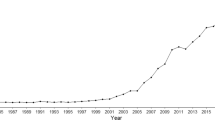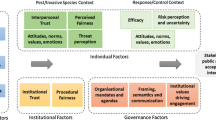Abstract
Invasion biology is a growing discipline with clear ecological, social and economic implications. A wide range of research effort is thus required to address the invasion problem, and literature on the topic is extensive. However, the extent to which the invasion biology research is addressing the challenges associated with management and mitigation of the impacts of invasions has been questioned. Using bibliometric analysis, we investigated the extent to which the literature on the subject contributes to implementation of knowledge generated, by addressing aspects of management, policy, and/or implementation; the impact of these papers as indicated by the number of citations they attract; and the geopolitical scale of focus of invasion ecology papers, particularly those that attempt to bridge the knowing-doing gap. We then compared these findings with the information needs of conservation practitioners. We first looked globally at popular search engines and then narrowed our focus to South Africa—one of three regions outside USA where researchers producing highly cited papers in invasion ecology are well represented. At this level, we conducted a content analysis of invasion ecology-related papers, of which at least one author was affiliated to a South African institution. The knowledge base in the field of invasion biology is comprised largely of research oriented towards “knowing”, while research aimed at strategically applying or implementing that knowledge is poorly represented in the scientific literature, and the scale of its emphasis is not local. Conservation practitioners clearly indicate a need for basic knowledge. However, invasion science must develop channels for effective engagement to ensure that the research is contextualised, and will deal with the complex ecological, social and economic challenges posed by invasions.

Similar content being viewed by others
References
Aronson J, Blignaut JB, Milton SJ et al (2009) Are socio-economic benefits of restoration adequately quantified? A meta-analysis of recent papers (2000–2008) in Restoration Ecology and 12 other scientific journals. Restor Ecol 18:143–154
Babbie E, Mouton J (2001) The practice of social research (South African edition). Oxford University Press, Cape Town
Briggs SV (2006) Integrating policy and science in natural resources: why so difficult? Ecol Manage Restor 7:37–39
Bullock H, Mountford J, Stanley R (2001) Better policy making. Centre for management and policy studies. Cabinet Office, London
Campbell LM (2005) Overcoming obstacles to interdisciplinary research. Conserv Biol 19:574–577
Choi BCK, Pak AWP (2006) Multidisciplinarity, interdisciplinarity and transdisciplinarity in health research, services, education and policy: 1. Definitions, objectives, and evidence of effectiveness. Clin Invest Med 29:351–364
Colautti RI, Richardson DM (2009) Subjectivity and flexibility in invasion terminology: too much of a good thing? Biol Invasions 11:1225–1229
Cumming GS, Cumming DHM, Redman CL (2006) Scale mismatches in social ecological systems: causes, consequences and solutions. Ecol Society 11:14 [online] URL: http://www.ecologyandsociety.org/vol11/
Davis MA (2009) Invasion biology. Oxford University Press, Oxford, p 288
Failing L, Gregory R (2003) Ten common mistakes in designing biodiversity indicators for forest policy. J Environ Manage 68:121–132
Gibbons P, Zammit C, Youngentob K et al (2008) Some practical suggestions for improving engagement between researchers and policy-makers in natural resource management. Ecol Manage Restor 9:182–186
Higgs E (2005) The two-culture problems: ecological restoration and the integration of knowledge. Restor Ecol 13:159–164
Hobbs R (2009) Looking for the silver lining: making the most of failure. Restor Ecol 17:1–3
Hulme PE (2003) Winning the science battles but loosing the conservation war? Oryx 37:178–193
Knight AT (2009) Is conservation ready to fail? Conserv Biol 23:517
Knight A, Cowling RM, Rouget M et al (2008) Knowing but not doing: selecting priority conservation areas and the research-implementation gap. Conserv Biol 22:610–617
Kueffer C, Hirsch Hadorn G (2008) How to Achieve Effectiveness in Problem-oriented landscape research: the example of research on biotic invasions. Living reviews in landscape research 2. URL (cited on 14 April 2010): http://www.livingreviews.org/lrlr-2008-2
Larson BMH (2007) An alien approach to invasive species: objectivity and society in invasion biology. Biol Invasions 9:947–956
Lawrence PA (2002) Rank injustice: the misallocation of credit is endemic in science. Nature 415:835–836
Lawrence PA (2007) The mismeasurement of science. Curr Biol 17:R583–R585
Lawton JH (1999) Are there general laws in ecology? Oikos 84:177–192
Linklater WL (2003) Science and management in a conservation crises: a case study with rhinoceros. Conserv Biol 17:968–975
Lockwood JL, Hoopes MF, Marchetti MP (2007) Invasion ecology. Wiley Blackwell, Oxford, p 304
Marais C, Wannenburgh AM (2008) Restoration of water resources (natural capital) through the clearing of invasive alien plants from riparian areas in South Africa—costs and water benefits. S Afr J Bot 74:526–537
Max-Neef MA (2005) Foundations of transdisciplinarity. Ecol Econ 53:5–16
McGeoch MA, Butchart SHM, Spear D, Marais E, Kleynhans EJ, Symes A, Chanson J, Hoffmann M (2010) Global indicators of biological invasion: species numbers, biodiversity impact and policy responses. Divers Distrib 16:95–108
McNie EC (2007) Reconciling the supply of scientific information with user demands: an analysis of the problem and review of the literature. Environ Sci Policy 10:17–38
Mouton J (2003) South African science in transition. Sci Techn Soc 8:235–260
Musil CF, Macdonald IAW (2007) Invasive alien flora and fauna in South Africa: expertise and bibliography. SANBI Biodiversity Series 6. South African biodiversity Institute, Pretoria
OECD (Organisation for Economic Co-operation and Development) (2002) Frascati manual: proposed standard practice for surveys on research and experimental development. OECD Publications, Paris
Perrings C, Williamson M, Barbier EB et al. (2002) Biological Invasion Risks and the public good: an economic perspective. Ecology 6(1): 1. [online] URL: http://www.consecol.org/vol6/iss1/art1
Pohl C (2008) From science to policy through transdisciplinary research. Environ Sci Policy 11:46–53
Pouris A (2006) A bibliometric assessment of South African research publications included in the internationally indexed database of Thomson ISI. In academy of science of South Africa (ASSAf). Report on a strategic approach to research publishing in South Africa. Marketing Support Services, Pretoria, pp 9–28
Pouris A (2007) The international performance of the South African academic institutions: a citation assessment. High Educ 54:501–509
Pyšek P, Richardson DM, Rejmánek M, Webster GL, Williamson M, Kirschner J (2004) Alien plants in checklists and floras: towards better communication between taxonomists and ecologists. Taxon 53:131–143
Pyšek P, Richardson DM, Jarošík V (2006) Who cites who in the invasion zoo: insights from an analysis of the most highly cited articles in invasion ecology. Preslia 78:437–468
Rhoten D, Parker A (2004) Risks and rewards of an interdisciplinary research path. Science 306:2046
Richardson DM, Pyšek P (2008) Fifty years of invasion ecology–the legacy of Charles Elton. Divers Distrib 14:161–168
Richardson DM, van Wilgen BW (2004) Invasive alien plants in South Africa: how well do we understand the ecological impacts? S Afr J Sci 100:45–52
Roux DJ, Rogers KH, Biggs HC et al. (2006) Bridging the science-management divide: moving from unidirectional knowledge transfer to knowledge interfacing and sharing. Ecol Soc 11:4 [online] URL: http://www.ecologyandsociety.org/col11/iss1/art4/
Sala OE, Chapin FS, Armesto JJ et al (2000) Global biodiversity scenarios for the year 2100. Science 5459:1770–1774
Seavy NE, Howell CA (2010) How can we improve information delivery to support conservation and restoration decisions? Biodivers Conserv 19:1261–1267
Shackleton C, Cundhill G, Knight A (2009) Beyond just research: experiences from southern Africa in developing social learning partnerships for resource conservation initiatives. Biotropica 41:563–570
Shanley P, López C (2009) Out of the loop: why research rarely reaches policy makers and the public and what can be done. Biotropica 41:535–544
Shaw JD, Wilson JRU, Richardson DM (2010) Initiating dialogue between scientists and managers of biological invasions. Biol Invasions. doi:10.1007/s10530-010-9821-9
Shirley SM, Kark S (2006) Amassing efforts against alien invasive species in Europe. PLoS Biol 4:1311–1313
Stinchcombe J, Moyle LC, Hudgens BR et al (2002) The influence of the academic conservation biology literature on endangered species recovery planning. Conserv Biol 6:15
Sunderland T, Sunderland-Groves J, Shanley P, Campbell B (2009) Bridging the gap: how can information access and exchange between conservation biologists and field practitioners be improved for better conservation outcomes? Biotropica 41:549–554
Sutherland WJ, Pullin AS, Dolman PM, Knight TM (2004) The need for evidence-based conservation. Trends Ecol Evol 19:305–308
Sutherland WJ, Armstrong-Brown S, Armsworth PR et al (2006) The identification of 100 ecological questions of high policy relevance in the UK. J Appl Ecol 43:617–627
Sutherland WJ, Adams WM, Aronson RB et al (2009) One hundred questions of importance to the conservation of global biological diversity. Conserv Biol 23:557–567
Wade N (1975) Citation analysis: a new tool for science administrators. Science 188:429–432
Weingart P (2005) Impact of bibliometrics upon the science system: inadvertent consequences? Scientometrics 62:117–131
Acknowledgments
The authors gratefully acknowledge the funding and support given by the DST-NRF Centre for Invasion Biology, Stellenbosch University, South Africa and The Andrew W. Mellon Foundation. We thank the management staff of SANParks that participated in the interview exercise and CREST for access to SA Knowledgebase, from which the South African-level data were extracted.
Author information
Authors and Affiliations
Corresponding author
Rights and permissions
About this article
Cite this article
Esler, K.J., Prozesky, H., Sharma, G.P. et al. How wide is the “knowing-doing” gap in invasion biology?. Biol Invasions 12, 4065–4075 (2010). https://doi.org/10.1007/s10530-010-9812-x
Received:
Accepted:
Published:
Issue Date:
DOI: https://doi.org/10.1007/s10530-010-9812-x




